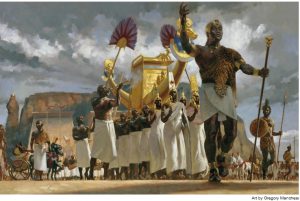
Last month Nick Cannon expressed his disdain for movies such as “Django Unchained” and “12 Years a Slave,” saying he’s tired of seeing Black people portrayed as slaves on film. Recognizing that African people’s history started prior to being enslaved, the actor tweeted that he would like to see Blacks portray kings and queens in films instead.
“Why don’t they make movies about our African kings & queens? #OurHistory I would love to see a film about Akhenaton and his beautiful wife Queen Nefertiti! Or Cetewayo, a king who was a war hero. Im about to drive to my office right now and start the development! New Hollywood Trend, Black king and queen films! Starring Black people!!”
Below are 10 kings and queens whose extraordinary accomplishments would make great storylines for films.
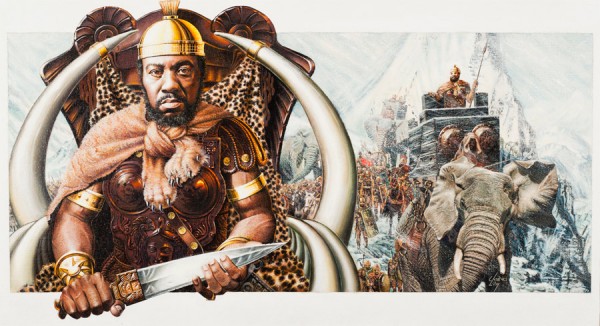
King Hannibal is said to be the greatest military leader and strategist of all time. Hannibal was born in 247 B.C., during the beginning of the decline of Carthage, then a maritime power near present-day Tunis in North Africa. The Carthage population was a mix of Africans and Phoenicians who were great merchants, trading with India, the people of the Mediterranean and the Scilly Isles.
When he was very young, about 8 or 9, Hannibal accompanied his father Hamilclar in a battle against the Romans. Seventeen years later in 221 B.C., he succeeded his brother-in-law Hasdrubal, and became supreme commander of the peninsula.
Hannibal had 80,000 infantry, 12,000 cavalry, and 40 African war elephants. He conquered major portions of Spain and France, and all of Italy, except for Rome.
Hannibal marched his army and war elephants through the Alps to surprise and conquer his enemies. In one battle, the Romans put 80,000 men on the field led by Scipio to defeat Hannibal. When Scipio attacked with his entire army, Hannibal had so studied the grounds that he arranged his African swordsmen and elephants to trampled and slaughter them.
After killing thousands of Roman soilders in lengthy battle, Hannibal took his own life rather than surrender when he was overwhelmed by the larger Roman army.

King Mansa Musa I (Emperor Moses) was an important Malian king, ruling from 1312 to 1337 and expanding the Mali influence over the Niger city-states of Timbuktu, Gao, and Djenne.
Musa ruled the Mali Empire and was estimated to have been worth the equivalent of $400 billion in today’s currency, which makes him the richest man to ever walk this earth. The emperor was a master businessman and economist, and gained his wealth through Mali’s supply of gold, salt and ivory, the main commodities for most of the world during that time.
Musa maintained a huge army that kept peace and policed the trade routes for his businesses. His armies pushed the borders of Mali from the Atlantic coast in the west; beyond the cities of Timbuktu and Gao in the east; and from the salt mines of Taghaza in the north to the gold mines of Wangar in the south.
Musa was also a major influence on the University of Timbuktu, the world’s first university and the major learning institution for not just of Africa but the world. Timbuktu became a meeting place of poets, scholars and artists of Africa and the Middle East. Even after Mali declined, Timbuktu remained the major learning center of Africa for many years.
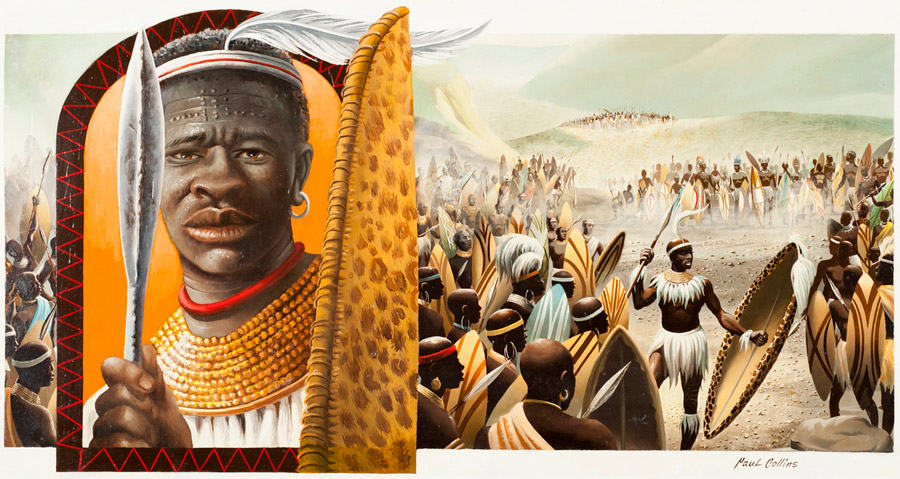
Shaka, king of the Zulus, was born in 1787, the son of Zulu Chief Senzangakhona and his wife Nandi. When Shaka was 26, his father died and left the throne to a son, Sijuana. Shaka ambushed and killed Sijuana, taking leadership of the Zulus. He came to power around 1818.
A strong leader and military innovator, Shaka is noted for revolutionizing 19th century Bantu warfare by first grouping regiments by age, and training his men to use standardized weapons and special tactics.
He invented the “assegai,” a short stabbing spear, and marched his regiments in tight formation, using large shields to fend off the enemies throwing spears. Over the years, Shaka’s troops earned such a reputation that many enemies would flee at the sight of them.
With cunning and confidence as his tools, Shaka built a small Zulu tribe into a powerful nation of more than a million people, and united all tribes in South Africa against European colonial rule. The Zulu nation continued to use Shaka’s innovations in wars after his death.
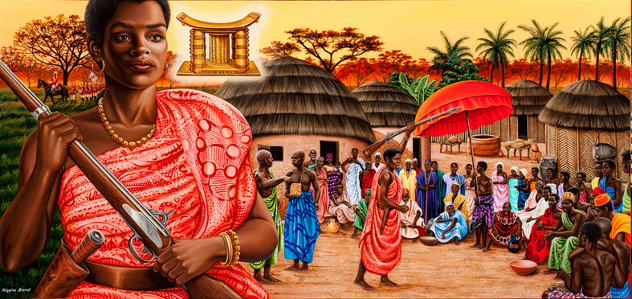
Near the end of the 19th century, the British exiled King Prempeh from the hinterlands of the Gold Coast (present day Ghana), in an attempt to take over. By 1900, still not gaining control, the British sent a governor to the city of Kumasi, the capital of the Ashanti, to demand the Golden Stool, the Ark of the Covenant for the Ashanti people.
The Golden Stool was the supreme symbol of the sovereignty and the independence of the Ashanti, a people who inhabited dense rain forests of what is now the central portion of Ghana. The governor in no way understood the sacred significance of the Golden Stool, which according to tradition, contained the soul of the Ashanti.
Nana Yaa Asantewa was present at the meeting with the governor and chiefs. When the meeting ended, and she was alone with the Ashanti chiefs, she said: “Now I have seen that some of you fear to fight for our king. If it were in the brave days of old, the days of Osei Tutu, Okomfo Anoyke and Opulu Ware, Ashanti chiefs would not sit down to see their king taken away without firing a shot. No white man could have dared speak to Ashanti chiefs in the way the governor spoke to you chiefs this morning.”
Nana Yaa Asantewa’s speech stirred the men. She said, “If you men will not go forward, then we the women will. I will call upon my fellow women. We will fight the white men until the last of us falls in the battlefields.”
The Ashantis, led by Nana Yaa Asantewa, fought very bravely.
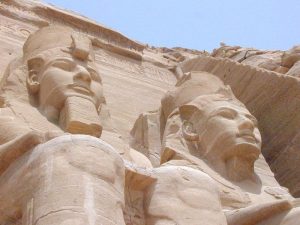
King Ramesses II, also referred to as Ramesses the Great, was the third Egyptian pharaoh of the 19th dynasty. He reigned from 1279 B.C. to 1213 B.C. He is often regarded as the greatest, most celebrated, and most powerful pharaoh of the Egyptian Empire. His successors and later Egyptians called him the “Great Ancestor.” Ramesses II led several military expeditions into the Levant, reasserting Egyptian control over Canaan. He also led expeditions south into Nubia, commemorated in inscriptions at the temples at Beit el-Wali and Gerf Hussein.
At age 14, Ramesses was appointed prince regent by his father Seti I. He is believed to have taken the throne in his late teens and is known to have ruled Egypt for 66 years and 2 months, according to Egypt’s contemporary historical records. He was once reported to have lived to 99 years old.
Queen Nefertari was the Nubian queen from 1292 to 1225 B.C. One of a many great Nubian queens, Nefertari is heralded as the queen who wed for peace. Her marriage to Ramesses II began strictly as a political move, a sharing of power between two leaders. But not only did it grow into one of the greatest royal love affairs in history, but brought the hundred year war between Nubia and Egypt to an end.
Their story was an armistice that lasted over a hundred years. Even today, a monument stands in Queen Nefertari’s honor. In fact, the temple which Ramesses built for her at Abu Simbel is one of the largest and most beautiful structures ever built to honor a wife.
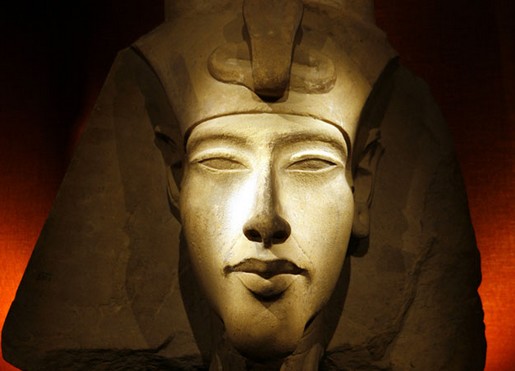
Amenhotep IV, better known as “Akhenaton” is in some respects the most remarkable of the pharaohs.
Akhenaton is considered the founder of the first monotheistic religion. He ruled from approximately 1352 – 1336 B.C., coming into power after his father, Amenhotep III, died. Akhenaton’s reign left a profound effect on Egypt and the entire world of his day. Thirteen hundred years before Christ, he preached and lived the gospel of perfect love, brotherhood, and truth. Two thousand years before Muhammed, he taught the doctrine of the “one God.” Three thousand years before Darwin, he sensed the unity that runs through all living things.
The account of Akhenaton is not complete without the story of his beautiful wife, Nefertiti. What is known is that the relationship between Akhenaton and Nefertiti was one of history’s first well-known love stories.
At the prompting of Akhenaton and Nefertiti, sculptors and artists began to recreate life in its natural state, instead of the rigid and lifeless forms of early Egyptian art.
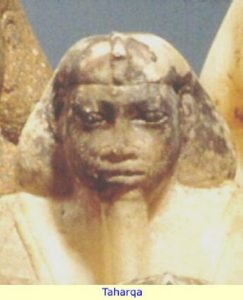
Taharqa is probably one of the most famous rulers of Napatan Kush, reigning from 690 to 664 B.C.. At 16, this great Nubian king led his armies against the invading Assyrians in defense of his ally, Israel. This action earned him a place in the Bible (Isaiah 37:9, 2 Kings 19:9).
During his 25-year rule, Taharqa controlled the largest empire in ancient Africa. His power was equaled only by the Assyrians. These two forces were in constant conflict, but despite continuous warfare, Taharqa was able to initiate a building program throughout his empire, which was overwhelming in scope. The number and majesty of his building projects were legendary, with the greatest being the temple at Gebel Barkal in the Sudan. The temple was carved from rock and decorated with images of Taharqa over 100 feet high.
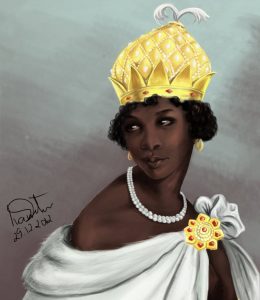
Queen Nzingha or “Amazon Queen of Matamba” was born in West Africa in 1583 and died 1663. Many women ranked among the great rulers of Africa, including this Angolan queen who was an astute diplomat and excelled as a military leader. When the slave-hunting Portuguese attacked the army of her brother’s kingdom, Nzingha was sent to negotiate the peace. She did so with astonishing skill and political tact, despite the fact that her brother had her only child killed.
She later formed her own army against the Portuguese, and waged war for nearly 30 years. These battles were a unique moment in colonial history as Nzingha allied her nation with the Dutch, marking the first African-European alliance against a European oppressor. Nzingha continued to wield considerable influence among her subjects despite being forced into exile. Because of her quest for freedom and relentless drive to bring peace to her people, Nzingha remains a glimmering symbol of inspiration.

In 960 B.C., the nation that is now called Ethiopia came back upon the center of the stage of history. Ethiopia was then represented by a queen, who in some books is referred to as “Makeda” or “Belkis.” She is better known to the world as the queen of Sheba.
In his book, “World’s Great Men of Color,” J.A. Rogers , gives this description: “Out of the mists of 3,000 years, emerges this beautiful story of an African queen who, attracted by the fame of a Judean monarch, made a long journey to see him.”
The queen of Sheba is said to have undertaken a long and difficult journey to Jerusalem to learn from the wisdom of the great King Solomon.
Makeda and King Solomon were equally impressed with each other. Out of their relationship was born a son, Menelik I. This queen is said to have reigned over Sheba and Arabia as well as Ethiopia. The queen of Sheba’s capital was Debra Makeda, which she built for herself.
In Ethiopia’s church of Aksum , there is a copy of what is said to be one of the Tables of Law that Solomon gave to Menelik I.
The story of the queen of Sheba is deeply cherished in Ethiopia, as part of the national heritage. This African queen is mentioned in two holy books, the Bible and the Quran.
Sources:
http://en.wikipedia.org
http://www.africanlegends.info
http://www.consciousplat.com
